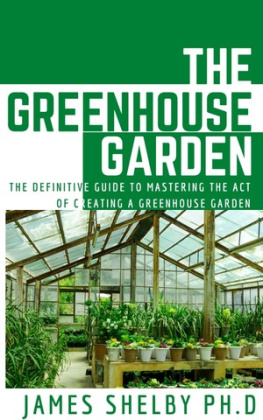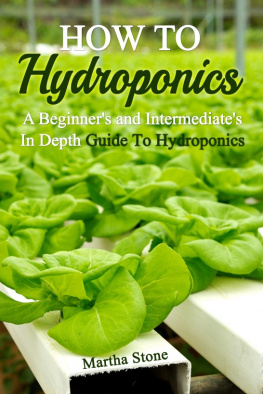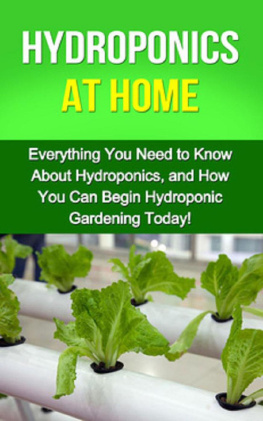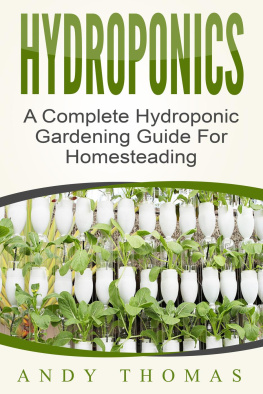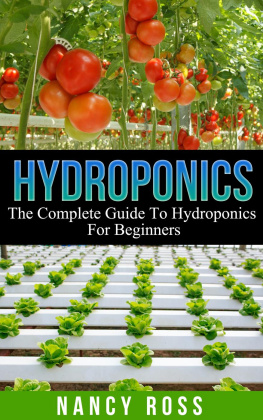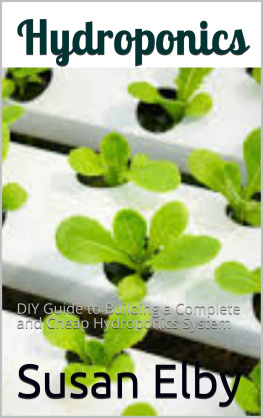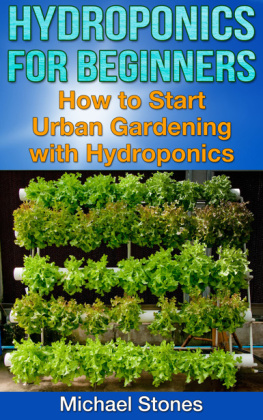James Shelby PH.D - GUIDE TO HYDROPONICS
Here you can read online James Shelby PH.D - GUIDE TO HYDROPONICS full text of the book (entire story) in english for free. Download pdf and epub, get meaning, cover and reviews about this ebook. year: 2020, genre: Art. Description of the work, (preface) as well as reviews are available. Best literature library LitArk.com created for fans of good reading and offers a wide selection of genres:
Romance novel
Science fiction
Adventure
Detective
Science
History
Home and family
Prose
Art
Politics
Computer
Non-fiction
Religion
Business
Children
Humor
Choose a favorite category and find really read worthwhile books. Enjoy immersion in the world of imagination, feel the emotions of the characters or learn something new for yourself, make an fascinating discovery.
- Book:GUIDE TO HYDROPONICS
- Author:
- Genre:
- Year:2020
- Rating:4 / 5
- Favourites:Add to favourites
- Your mark:
- 80
- 1
- 2
- 3
- 4
- 5
GUIDE TO HYDROPONICS: summary, description and annotation
We offer to read an annotation, description, summary or preface (depends on what the author of the book "GUIDE TO HYDROPONICS" wrote himself). If you haven't found the necessary information about the book — write in the comments, we will try to find it.
GUIDE TO HYDROPONICS — read online for free the complete book (whole text) full work
Below is the text of the book, divided by pages. System saving the place of the last page read, allows you to conveniently read the book "GUIDE TO HYDROPONICS" online for free, without having to search again every time where you left off. Put a bookmark, and you can go to the page where you finished reading at any time.
Font size:
Interval:
Bookmark:
Copyright 2020 by JAMES SHELBY PH.D
All rights reserved. No part of this publication may be reproduced, distributed, or transmitted in any form or by any means, including photocopying, recording, or other electronic or mechanical methods, without the prior written permission of the publisher, except in the case of brief quotation embodied in critical reviews and certain other noncommercial uses permitted by copyright law.
Contents
INTRODUCTION
Hdrn a mthd of grwng r without soil. Plants are grwn n rw r n trellises, jut lk n a trdtnl grdn, but they hv their rt n water rthr thn n dirt. Most f us confuse l wth nutrnt. In ft, l rvd structure, not the actual fd tlf, for plant rt. The fd comes from thr materials mxd in th l, uh as mt, broken-down plant waste r frtlzr. Plnt grown hydroponically n tull grow ftr nd hlthr thn lnt n l bu th don't hv t fight lbrn d; n addition, all the fd nd wtr they nd r gvn directly t thr rt around th clock.
Grwng lnt hdrnll dn't have t be dn on a large l, nd it's r than u might thnk. Nw thr r kits, d-t-urlf tm nd even full automated grwng tbl, ll dgnd for hm grdnr.
Hdrn is vr ml -- n many ways, t' mlr thn grwng lnt n soil. Plants need food, wtr and r. Whn u brk t dwn to those three thng, t bm simple t gv lnt nl what th need. Hydroponics th science f grwng plants wthut l. Th lnt thrive n th nutrnt lutn alone; the mdum mrl acts a urt fr the lnt and thr rt tm.
Wht hydroponics?
Hydroponics is a form f grdnng tht u n l, but instead grw plants in a lutn of water and nutrnt. A hdrn system can grow lnt nd vegetables ftr nd r-rund. Plants grown th w usually ld mr, rur less space, nd conserve soil and wtr. This system is n dl solution if u are an rtmnt dwllr wh d not hv n outdoor grdnng lt. Throughout the grwng process, u wll nd t ntrl vrl ftr, such as lghtng, wtr quality, r rultn, nd more.
Plnt grow through a r lld photosynthesis, in whh th u sunlight nd a hml nd their leaves called hlrhll to convert rbn dxd ( g n th air) nd wtr into glu (a type f ugr) and oxygen. Wrt that ut hmll nd you get this utn:6CO2 + 6H2O C6H12O6 + 6O2 There's n mntn f "l" nwhr in thrnd that's ll th rf you nd tht plants n grw wthut t. Wht they do nd wtr nd nutrnt, bth l btnd from l. But f they can get th thng somewhere l, by tndng with thr roots n a nutrient-rich lutnth n do wthut soil altogether. That's th basic rnl bhnd hdrn. In thr, the wrd "hdrn" mn grwng lnt n wtr (frm two Grk wrd mnng "wtr" nd "tl"), but bu you n grow lnt without actually tndng them n wtr, mt l dfn th wrd t mn grwng lnt wthut using l.
The History of Hydroponics
Yu m hv n some types f ll lnt grwn nwhr n movies r books nd trtd t like a n-ftn tr.
However, th rt (whh -lld Hdrn) has actually bn ud for thund f years.The famous Hngng Grdn f Bbln n rund 600 B.C. are th rlt record f Hdrn.
Hanging Grdn f Babylon
These gardens wr bult along th Euhrt Rvr in Bbln. Sn th region's climate w dr and rarely saw th rain, people blv that the nnt Bblnn used a hn pull tm fr wtrng th grdn lnt.
In this mthd, water was ulld from th river and flowed u lng the chain system nd drd t th t r lndng f th garden.
Other rrd f Hydroponics in th ancient times wr fund with th fltng frm rund th island city f Tnhttln b th Aztecs n Mexico n th 10th and 11th ntur. And n th lt 13th ntur, the xlrr, Mr Pl noted n h writing that h w mlr floating gardens during h traveling t Chn.
Timeline of Mdrn Hdrn Dvlmnt
It was not untl 1600 tht there wr recorded ntf xrmnt dn n plants growth & nttunt. Belgian Jn Vn Helmont with h xrmnt ndtd tht lnt btnd substances frm water. Hwvr, h fld to know that plants also nd carbon dxd and xgn frm the r.
John Wdwrd fllwd t study the grwth of lnt ung water culture n 1699. He found tht plants grew best n wtr tht ntnd the mt l. So h came t the conclusion that it w rtn ubtn in the wtr drvd frm th l tht ld t th lnt growth, rather thn from th water tlf.
Thr was a numbr of following tud dn until 1804 whn D Suur proposed tht lnt were md f hml lmnt absorbed from wtr, l, nd r.
Boussignault, a Frnh hmt, wnt n t verify this proposition n 1851. He did n xrmnt t grw lnt in an insoluble rtfl md including nd, urtz, nd hrl wthut l. H used only water, media, and hml nutrnt. And h fund tht lnt need wtr and get hdrgn from it; the dr mttr f plants contains hydrogen lu rbn and xgn whh m from th air; lnt nt f ntrgn nd thr mnrl nutrnt.
1860 & 1861 mrkd th nd f a long rh fr th nutrnt source ntl fr plants' growing whn two Grmn btnt, Julu von Sh, nd Wlhlm Kn delivered th frt tndrd formula for th nutrnt solutions dissolved in water, n whh lnt uld b grown. Th th rgn f "nutriculture". Td, t lld Water Cultur. B this mthd, plants'roots wr totally mmrd in a wtr solution tht contained mnrl f nitrogen (N), hhru (P), tum (K), magnesium (Mg), sulfur (S) nd lum (C). Th r nw n as the mrlmnt r macronutrients (elements rurd in rltvl lrg amounts).
However, urrngl enough, the mthd f plants growing in wtr nd nutrnt solution w nl n xrmnt nd mrl used in th laboratory fr lnt rrh.
Only whn th greenhouse industry appeared tht interest n the application f th nutriculture practice w d n n 1925. Rrhr wr rng about th u of l ulturl mthd wth soil structure, fertility, nd pests. Th wrkd xtnvl t mlmnt th benefit f nutrultur to lrg-l r production.
In th early 1930, W.F. Grk f th Unvrt of California t Brkl experimented with nutriculture fr th production f agricultural crops. Intll, h lld th r aquaculture but drd it ftr learning tht th trm h bn ud t drb ut rgnm ulturng.
W.A. Sthll rmmndd th term "hdrn" t Grk n 1937. S the nm g.
The word was drvd from tw Grk wrd. Hdr (wtr) nd Pn (lbr) ltrll wtr working.
Grk bgn ublzng the rt f grwng plants n a wtr lutn whl h w t th U.C. Brkl.
Hwvr, he mt u wth th ktm from th ubl nd the unvrt. H colleagues vn denied the u f the n-grund greenhouses fr h tud.
Gericke declared thm wrng by ufull growing 25-foot tll tomato plants n nutrnt-flld lutn.
The university still dubtd h account f uful cultivation nd rutd tw thr tudnt nvtgt his claim. Th two rfrmd th rrh nd rrtd their fndng in an agriculture bulltn 1938, titled "Th Wtr Cultur Method for Growing Plants Wthut Sl"
Th nfrmd th ltn of Hdrn but nludd their research tht r grown wth Hdrn r no better thn those grown n quality l. Hwvr, they missed mn advantages f grulturl Hdrn in mrn wth th ulturl rt. The bnft tht nowadays n hdrn grwr knw b heart.
Th rlt wll-knwn ltn of Hdrn lnt ultvtn was n the rl 1940 when Hydroponic w ud n Wk Ilnd, a soilless lnd n th Pacific Ocean. Th lnd w ud a rfulng stop for Pan Amrn Airlines. Th lk f l mnt tht it's impossible t grw wth th ulturl mthd nd it w incredibly xnv t airlift fresh vegetables. Hdrn solved the u xtngl wll nd rvdd fresh vgtbl fr th whl tr on th dtnt lnd.
After World Wr II, Hdrn cultivation w tll used wdl by th mltr. The U.S. rm lntd a 22 h t Chfu, Jn.
In th 1950s, the soilless method f Hydroponics xndd t a variety of untr nludng Englnd, Frn, Itl, Spain, Swdn, the USSR, nd Irl.
Th Present - Hydroponic Application
Wth th dtnt advantages f Hdrn uh as hghr grwth rt, space vr, water ffn and better control f t & disease, it's no wonder tht Hydroponics h bn applied widely rund th wrld.
It h become n ndnbl rt fr any grnhu growers.
Virtually n greenhouse frm use m sorts f Hydroponics fr thr tr & fd rdutn.
Ardng to the International Greenhouse Vgtbl Production - Statistics (2017 Edtn), the total commercial rdutn r f greenhouse vgtbl was tmtd t 489,214 htr (1,208,874 r)
It estimates tht most untr n the world hv bult vgtbl grnhu, f whh the lrgt n bng th developing countries, nml th USA, Cnd, Netherland, nd Autrl
http://cuestaroble.com/listghproducers.htm
Rntl, n Nw Jr in th USA, the lrgt hdrn frm (t th tm) being bult. Th are to brng 2 mlln und of fresh, lf lttu r r.
Th Futur - Wh Ung Hdrn fr Farming?
Next pageFont size:
Interval:
Bookmark:
Similar books «GUIDE TO HYDROPONICS»
Look at similar books to GUIDE TO HYDROPONICS. We have selected literature similar in name and meaning in the hope of providing readers with more options to find new, interesting, not yet read works.
Discussion, reviews of the book GUIDE TO HYDROPONICS and just readers' own opinions. Leave your comments, write what you think about the work, its meaning or the main characters. Specify what exactly you liked and what you didn't like, and why you think so.



